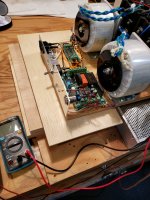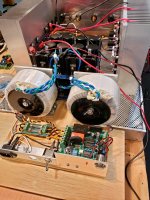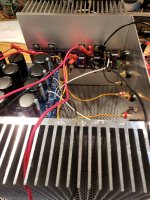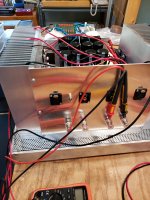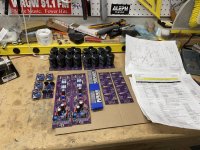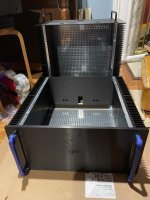I didn't test my PSU in stages, just built it up & powered it on without hooking it up to any amp boards. I have an incandescent light bulb in series thing use to power it on the first time, and I watch for the filament to go from bright to dark as a sign that things are working as they should. I'll frequently use the light bulb when the PSU is powering up amp boards for the first time too.
This amp is amazing.
If you haven't built at least an Aleph 30, go build it & listen to it with a good 2-way. I remain stunned by the thrust and detail, the clarity and resolution this amp delivers into 10" mid-woofers paired with 1.5" dome tweeters. Simply love it. Vinyl sounds better than ever, so does 80's era music mixed for CD. Especially the latter. I can't stop listening to The English Beat on vinyl or Tones On Tail on CD.
If you haven't built at least an Aleph 30, go build it & listen to it with a good 2-way. I remain stunned by the thrust and detail, the clarity and resolution this amp delivers into 10" mid-woofers paired with 1.5" dome tweeters. Simply love it. Vinyl sounds better than ever, so does 80's era music mixed for CD. Especially the latter. I can't stop listening to The English Beat on vinyl or Tones On Tail on CD.
Does anyone want to hazard what might happen if I were to throw another four MOSFETs on this thing & turn it into an Aleph 40? Keep in mind I'm working with a 300VA trafo and I'm not going dual mono for this.
It sounds like you have a great amp to enjoy music. The best recommendation when you have that is to leave it alone.
An Aleph 40 build would be best with a pair of 300VA transformers, as dual-mono or even separate monoblocks.
An Aleph 40 build would be best with a pair of 300VA transformers, as dual-mono or even separate monoblocks.
From your earlier post you have +/-20.7V rails and that is already too low even for 30W into 8 ohms and adding more mosfets won't change that. Assuming you don't change the bias per mosfet, however, you will get more current, which can help if you are driving into low impedances.
300VA is probably on the low side for any significant increase in current in a stereo build; I personally wouldn't do it. Then there's the matter that the additional mosfets need to match with your existing ones...
Anyway, I would suggest keeping and enjoying your A-30 as-is.
300VA is probably on the low side for any significant increase in current in a stereo build; I personally wouldn't do it. Then there's the matter that the additional mosfets need to match with your existing ones...
Anyway, I would suggest keeping and enjoying your A-30 as-is.
Good points, both. I suppose the additional sag on the rails would complicate any benefit of higher transconductance and lower Zout from a fourth set of devices. And my 10" drivers don't sound to me like they need more control, either.
Not sure why a fourth device pair merits a doubling of trafo VAC though. Three devices biased at 2.1A/ch dissipates ~85W/ch; that's a little over 1/2 of 300VA; all else being equal I'd think a 400VA or two 200VA trafos would do it for an Aleph 40.
Not sure why a fourth device pair merits a doubling of trafo VAC though. Three devices biased at 2.1A/ch dissipates ~85W/ch; that's a little over 1/2 of 300VA; all else being equal I'd think a 400VA or two 200VA trafos would do it for an Aleph 40.
Ranshdow,
I have filled the fourth pair in my set of boards as you were thinking of doing. I really don't think you can call it an Aleph 40 because I think that there were differences in component values and voltage as well. I used two Antek 3220 transformers in dual mono configuration with 216,000 mf per channel. That configuration provided 29.3V unloaded and 25.8V loaded. In my test configuration I biased each device for around 0.7A, which gave me about 2.8A per channel. I found the 240s so well matched that little adjustment was required for the bias and offset. I will wait until the amp is in its final case before adjusting the AC gain.
I did a quick listening test to compare it with my Aleph J and found the base was better and it sounded slightly darker. I didn't play it for very long as it was under heatsinked even with the babysitter I was using, so it was more a proof of concept than a reasonable comparison. I plan to install it in a deluxe 5U 400 and see how much bias I can get out of it. It is going to be the top end for my LX Mini speakers with a pair of F5 Turbo V3 monoblocks in 5U 400 cases for the bottom end. As the impedance is 4 ohms for these speakers, I need all the bias current I can get.
I have filled the fourth pair in my set of boards as you were thinking of doing. I really don't think you can call it an Aleph 40 because I think that there were differences in component values and voltage as well. I used two Antek 3220 transformers in dual mono configuration with 216,000 mf per channel. That configuration provided 29.3V unloaded and 25.8V loaded. In my test configuration I biased each device for around 0.7A, which gave me about 2.8A per channel. I found the 240s so well matched that little adjustment was required for the bias and offset. I will wait until the amp is in its final case before adjusting the AC gain.
I did a quick listening test to compare it with my Aleph J and found the base was better and it sounded slightly darker. I didn't play it for very long as it was under heatsinked even with the babysitter I was using, so it was more a proof of concept than a reasonable comparison. I plan to install it in a deluxe 5U 400 and see how much bias I can get out of it. It is going to be the top end for my LX Mini speakers with a pair of F5 Turbo V3 monoblocks in 5U 400 cases for the bottom end. As the impedance is 4 ohms for these speakers, I need all the bias current I can get.
Attachments
@rpafenberg - that's not enough heatsink!?!! How hot was it getting?
@ranshdow - As it's been pointed out, to get to 40W you're going to need more rail voltage. Also note that the Aleph 5 got 60W using 3up / 3 down MOSFETs per channel. So 6x IRFP240's per channel are certainly up to the task for 30W, 40W, or 60W. Which is to say that you don't need a 4th pair of MOSFETs.
You could consider a higher voltage donut. But... Do you have the PSU cap voltage? Will the heatsinks take it / how hot are you willing to go? You can always play with turning up the bias current, too.
@ranshdow - As it's been pointed out, to get to 40W you're going to need more rail voltage. Also note that the Aleph 5 got 60W using 3up / 3 down MOSFETs per channel. So 6x IRFP240's per channel are certainly up to the task for 30W, 40W, or 60W. Which is to say that you don't need a 4th pair of MOSFETs.
You could consider a higher voltage donut. But... Do you have the PSU cap voltage? Will the heatsinks take it / how hot are you willing to go? You can always play with turning up the bias current, too.
@rjthatcher - I didn't expect it to be🙂. It was a test rig with a babysitter. I cut it off when it wouldn't pass a 5 second touch test. It will be interesting to see how far I can bias a 5U 400.
@rpafenberg I appreciate the listening notes, esp as the Aleph J is so well regarded. My friend has one and I've borrowed it but it apparently wasn't biased correctly at the time. As it stands today I'm definitely a fan of what I have. I like the look of your build btw.
@rhthatcher Also good to know I can go to higher voltage swings with the Aleph 30 as it is. The PSU caps are 35V so they could take it. The 4U 300 heatsinks get quite hot (2-3 second palm hold max) so I'd think a higher swing or current would require an upgrade beyond just the trafo. The 5U 400 heatsinks in the monoblock chassis are listed at 0.28C/W which isn't much higher than the 0.31C/W of the 4U 300s, but there are two of them in a monoblock so maybe it is enough? I haven't torn open my monoblock kits to see how exactly an Aleph 30 board would mount.
@rhthatcher Also good to know I can go to higher voltage swings with the Aleph 30 as it is. The PSU caps are 35V so they could take it. The 4U 300 heatsinks get quite hot (2-3 second palm hold max) so I'd think a higher swing or current would require an upgrade beyond just the trafo. The 5U 400 heatsinks in the monoblock chassis are listed at 0.28C/W which isn't much higher than the 0.31C/W of the 4U 300s, but there are two of them in a monoblock so maybe it is enough? I haven't torn open my monoblock kits to see how exactly an Aleph 30 board would mount.
For the fearless Aleph 2 builders, I have all boards and 2 5U chassis ready to go for a pair of 2’s. Next up is assembly, wiring, test/cooking. My household is getting over a mild case of Covid-19, and I’m back to work at my day job on Monday. There will be plenty of catching up to do. I’ll see where I can get bench time in over the next 1-2 weeks.
I did a copy / paste job to the Aleph 60 build notes for a new Aleph 2 document. I’m building based on my draft document. Once the first mono amp is up and running I’ll publish the updated document.
I did a copy / paste job to the Aleph 60 build notes for a new Aleph 2 document. I’m building based on my draft document. Once the first mono amp is up and running I’ll publish the updated document.
Attachments
Last edited:
Oh, I like the look of that!For the fearless Aleph 2 builders, I have all boards and 2 5U chassis ready to go for a pair of 2’s. Next up is assembly, wiring, test/cooking. My household is getting over a mild case of Covid-19, and I’m back to work at my day job on Monday. There will be plenty of catching up to do. I’ll see where I can get bench time in over the next 1-2 weeks.
I did a copy / paste job to the Aleph 60 build notes for a new Aleph 2 document. I’m building based on my draft document. Once the first mono amp is up and running I’ll publish the updated document.
Glad you are on the mend. Work woke me up in the middle of the night and I couldn't go back to sleep. I was staring at the picture in the middle of the night trying to figure what the difference was between the Aleph 60s you built and this Aleph 2. Looking again this morning it seems like in the Aleph 2 the 1st and 4th mosfet positions have fets up and down while the 2nd and 3rd position has one up and then one down, where the Aleph 60s had 6 matched pairs up and down using 3 of the 4 positions. Looking at an old Aleph 2 schematic compared to the schematic in the UMS Aleph 30/60 they look very similar. So, what am I missing?
Also, if memory serves me well you have some very efficient horn based speakers at home. What do notice going from the initial Aleph 30 build to the Aleph 60s monoblock in an efficient speaker?
Also, if memory serves me well you have some very efficient horn based speakers at home. What do notice going from the initial Aleph 30 build to the Aleph 60s monoblock in an efficient speaker?
Aleph 2 has bigger chassis (more heat sinks!), higher rail voltage (different donuts, higher rating on psu caps), and some values change on the boards. MOSFET count is the same.Glad you are on the mend. Work woke me up in the middle of the night and I couldn't go back to sleep. I was staring at the picture in the middle of the night trying to figure what the difference was between the Aleph 60s you built and this Aleph 2. Looking again this morning it seems like in the Aleph 2 the 1st and 4th mosfet positions have fets up and down while the 2nd and 3rd position has one up and then one down, where the Aleph 60s had 6 matched pairs up and down using 3 of the 4 positions. Looking at an old Aleph 2 schematic compared to the schematic in the UMS Aleph 30/60 they look very similar. So, what am I missing?
Also, if memory serves me well you have some very efficient horn based speakers at home. What do notice going from the initial Aleph 30 build to the Aleph 60s monoblock in an efficient speaker?
There are 4 heat sinks on the 5U deluxe psu, so my strategy is to put 3 MOSFETs per heatsink. Therefore this time I’m very deliberate in how I space them out. That’s a note I’ll be making in the build document.
Regarding differences, I think the sonic signature is consistent.
Randy,Aleph 2 has bigger chassis (more heat sinks!), higher rail voltage (different donuts, higher rating on psu caps), and some values change on the boards. MOSFET count is the same.
There are 4 heat sinks on the 5U deluxe psu, so my strategy is to put 3 MOSFETs per heatsink. Therefore this time I’m very deliberate in how I space them out. That’s a note I’ll be making in the build document.
Regarding differences, I think the sonic signature is consistent.
What’s the rail voltage on the Aleph 2? Overall Bias? And by knowing that, the overall dissipation per channel would be?
Is this is a 5U/500 or 5U/400?
I haven’t ordered my donut, chassis or capacitors yet, so this may be an option ;-)
That being said, I would like to use the 4U/500 which may or may not suit depending on the overall dissipation. More of a mental exercise since the increase in power is immaterial in my system, given that my mains are 96dB sensitive.
Best,
Anand.
Got it! So the output boards don't care which position the Mosfets are in as long as there is a symmetric number up and down. That's awfully slick, certainly gives you options to spread heat better as you mentioned (not that I am surprised at this point).Aleph 2 has bigger chassis (more heat sinks!), higher rail voltage (different donuts, higher rating on psu caps), and some values change on the boards. MOSFET count is the same.
There are 4 heat sinks on the 5U deluxe psu, so my strategy is to put 3 MOSFETs per heatsink. Therefore this time I’m very deliberate in how I space them out. That’s a note I’ll be making in the build document.
Regarding differences, I think the sonic signature is consistent.
Interesting that the sonic differences are similar. Now knowing the Aleph 2 is using the same number of Mosfet pairs as the Aleph 60 but at higher rail voltage and bias do you see any measured difference in THD or THD spectrum? Or is it just a route of getter more output power?
Anand,
Here you go. I made a spreadsheet of "Aleph Differences" when I set out on this project with all the different resistor values, etc. Here's the big data points I think you're looking for.

Here you go. I made a spreadsheet of "Aleph Differences" when I set out on this project with all the different resistor values, etc. Here's the big data points I think you're looking for.
The only 2 MOSFETS that matter for spacing are Q6 & Q10, they must be populated. From there they can be in any position. Mix and match. Just make sure the total number in the "up" positions (current source) is the same as the total in the "down" positions (outputs). I wanted this to be a flexible / swiss army knife setup. Good for Aleph mini, 3, 30, 5, 60, 2, 4, 1.2, and beyond.Got it! So the output boards don't care which position the Mosfets are in as long as there is a symmetric number up and down. That's awfully slick, certainly gives you options to spread heat better as you mentioned (not that I am surprised at this point).
Interesting that the sonic differences are similar. Now knowing the Aleph 2 is using the same number of Mosfet pairs as the Aleph 60 but at higher rail voltage and bias do you see any measured difference in THD or THD spectrum? Or is it just a route of getter more output power?
If you wanted to make an Aleph MINI with 1 set of MOSFETS, use positions Q6 & Q10 and leave the rest empty.
Bigger than a Mini? Mix and match with main + expansion board(s) to distribute around the heatsinks.
I haven't done any THD measurements or spectra on these, funny enough. I build, warm up, twist the pots, cook more, and do final test / adjust. Then it's off the bench and time to listen. They have the "Classic Aleph" sound I love.
I think the “Swiss army knife” approach is brilliant. Start with an Aleph 30, not enough juice for your speakers add the expansion boards and boost rails to Aleph 60. Still haven’t got your AC/DC up to 11, bigger donuts, bigger rails and bigger bias/chassis gets you there.
@CoGT3
Referring back to your question. Although I haven’t measured the THD yet, I would imagine, given that it is a Pass design, that higher bias will lower THD at the 1 watt level down to a certain point. That being said 2.2A is already quite a bit of bias. I also imagine that the THD will be lower at certain power levels when you compare one amp to the other. For example, when the Aleph 3 is clipping at 30 watts (and THD is >1%), the Aleph 2 is just loafing along. So differences may be heard at much higher power levels.
It’s important to find a set of sensitive speakers you love since it can be cheaper in the long run. Alas, we are FAB’s and these amps won’t be our last ;-)
Thanks for the table Randy, answers everything!
Best,
Anand.
Referring back to your question. Although I haven’t measured the THD yet, I would imagine, given that it is a Pass design, that higher bias will lower THD at the 1 watt level down to a certain point. That being said 2.2A is already quite a bit of bias. I also imagine that the THD will be lower at certain power levels when you compare one amp to the other. For example, when the Aleph 3 is clipping at 30 watts (and THD is >1%), the Aleph 2 is just loafing along. So differences may be heard at much higher power levels.
It’s important to find a set of sensitive speakers you love since it can be cheaper in the long run. Alas, we are FAB’s and these amps won’t be our last ;-)
Thanks for the table Randy, answers everything!
Best,
Anand.
- Home
- Amplifiers
- Pass Labs
- Classic Aleph Amplifier for Modern UMS Chassis Builder's Thread
